Explosives Sensing Using Multiple Optical Techniques in a Standoff Regime with a Common Platform
Combining multiple sensors into one instrument increases the probability of detecting explosive residues and enables the detection of a greater number of explosives.
The use of multiple optical sensor modalities in a common platform for explosives detection has many advantages over single-sensor design. The combination is particularly useful in a standoff regime. A short overview of the advantages of such a sensor is discussed here, along with the engineering goals and field testing of a recently built prototype.
Improvised explosive devices (IEDs) in the form of suicide bombers, roadside bombs, and vehicle-borne IEDs (VB-IEDs) are a persistent threat to U.S. troops in the current war on terror. However, detecting and preventing the use of these devices has proven difficult, primarily because the materials to build such devices are readily available to the would-be terrorist and are often commonly used for nonexplosive activities. Stopping the transport of bomb-building materials or locating IED factories would go a long way in preventing the creation of IEDs, which is preferable to detecting and defending against a single IED threat. Unfortunately, few reliable techniques exist for finding explosives in transit, and expert bomb makers cleverly conceal their IED laboratories.
Detecting bomb-making materials as cargo or finding IED labs is difficult because such materials may present themselves in inconspicuous forms or may be present only in trace amounts away from the actual source. Unlike a carry-on bag at the airport, where explosives can be detected through the use of X-ray and related imaging technologies, penetrating radiation technologies are much more difficult to deploy in a combat theater, and they require potentially unsafe levels of radiation that can penetrate a variety of materials. Moreover, such technology may miss small amounts of trace material in fingerprints or spillage that would be much easier to detect if a bomb maker or transporter of explosives had less than impeccable hygiene. Trace-explosive detection technologies would be the tool of choice in such a scenario.
At present, the most commonly used techniques for trace explosives detection are canines and variants of ion mobility spectrometry (IMS) and mass spectrometry (MS). Although these methods are very sensitive to trace explosives, they place the instrument and operator in very close proximity to the device. Additionally, canines require lengthy training, need rest periods, and can be distracted. In the cases of IMS and MS, the sample must be introduced into the instrument with a swipe or air sampling, which creates well-known sampling problems, such as cross-contamination, detector saturation, or excessive analysis times.
Because of the desire for standoff capabilities and real-time detection, laser-based techniques have been proposed as alternatives to the aforementioned methods. Some laser-based methods can analyze explosives from a safe standoff distance of several meters. Moreover, laser-based methods can offer sensitivity and specificity similar to IMS instruments under certain circumstances without the sampling issues previously mentioned.
Of the possible laser-standoff methods available, laser-induced breakdown spectroscopy (LIBS) and Raman spectroscopy have emerged as two of the top contenders for trace-quantity explosive detection (1–3). However, each technique has its own strengths and weaknesses in the areas of sensitivity, selectivity, and standoff capabilities. For example, LIBS offers high sensitivity to molecule types, but lacks specificity. The abilities of Raman spectroscopy fall at the other extreme.
Some of the pitfalls of LIBS and Raman spectroscopy can be remedied by enhancing them individually and by combining them into a single instrument. For example, LIBS signals can be enhanced significantly in a dual laser pulse technique called Townsend effect plasma spectroscopy (TEPS) (4) to extend the standoff distance and sensitivity. When combined with multiwavelength Raman for increased selectivity, a single sensor sharing much of the same hardware offers a higher probability of finding explosive residues than TEPS or single-wavelength Raman alone (5). Further advantages of the multitechnique approach and its use in a current system are discussed here.
Description of Hardware
Alakai (Largo, Florida) has designed a prototype sensor platform called the Checkpoint Explosives Detection System (CPEDS) using Raman and TEPS hardware for explosives detection at primarily military checkpoints. The system operates from standoff distances for the analysis of trace residues on surfaces and substances related to the manufacture of IEDs. All components of the system are stored inside a customized military S-250 shelter for protection against dust and environmental variation. Because of this compartmentalization, it can be loaded on the back of a high-mobility multipurpose wheeled vehicle (HMMWV) for transport to investigations of potential IED-building laboratories (Figure 1).
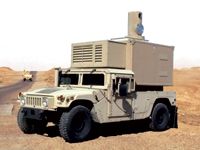
Figure 1: The Alakai CPEDS system on the back of a military HMMWV.
Figure 2 shows a simplified laboratory setup for a multisensor system like that in CPEDS, but in actual practice, an automated system of optics and actuators is needed for practical operation of any laser spectroscopy system in a standoff regime. For example, CPEDS has an actuated turret that contains a window that serves as the exit and entrance port of light from the system. Entering light is passed to a computer-controlled spectroscopic system. The exiting light (that is, the laser light) is focused with electronically actuated optics and is aligned to cameras inside the system and on the turret. The output of these cameras is shown on a computer that can control the spectrometer and data analysis settings for the currently selected technique from several meters away by means of computer networking and custom software (Figure 3).

Figure 2: Experimental setups for TEPS and multiwavelength UV Raman experiments using shared hardware in a laboratory setting. For the setup shown here, the second UV laser can be used for Raman in a similar fashion to UV Laser 1. The figures are simplifications of the much more complicated hardware used by CPEDS.
To select targets, the CPEDS computer uses an attached joystick that controls the turret position and fires the lasers. The user rotates the turret with the joystick until the desired interrogation area appears in the center of the field of view of the cameras. Reticles in the center of the field of view show the exact interrogation point of the system to make aiming precise. A simple press of a button on the joystick fires the lasers, collects a spectrum, processes the spectral data, and provides simplified output indicating the presence or absence of explosive for the spectroscopic technique in use.
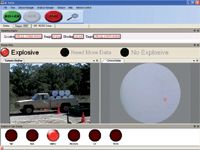
Figure 3: The software interface of the CPEDS system showing the live video feeds of an inspected vehicle with cargo.
Though the computer software can remove much of the system complexity for the user in a multisensor system, sharing the hardware, such as a common UV laser and detector hardware as in Figure 2, can simplify the system design and provides other advantages. TEPS uses the UV laser at high power density to create a plasma, while using a CO2 TEA laser to sample a larger surface and enhance the signal. The Raman setup can use the same UV laser by itself in a lower energy density mode. Laser sharing is possible because TEPS is almost independent of the wavelength used to create the plasma, and Raman benefits from the use of UV light (6), as detailed later. The system can include other UV lasers for multiwavelength Raman or other laser-based methods set for inclusion in CPEDS, but the spectrometer for the techniques can be kept common while enabling each technique to be operated separately from the others. Even so, the nondestructive sampling of Raman means that the same region can be interrogated with the sample-destructive TEPS functionality, creating the possibility of data fusion between the sensors.
The use of a UV laser in the system illustrates another advantage of the combination of LIBS or TEPS and Raman. It is widely known that the intensity of a Raman signal is proportional to the fourth power of the frequency of the irradiation. Moreover, the absorption of light tends to increase deeper into the UV. For Raman, this enables the possibility of resonance and preresonance Raman, so named because, as the wavelength of the excitation source approaches an electronic resonance absorption in a material, significant amplification of the Raman signal occurs (7). The increased absorption of materials in the UV region also increases the probability of a tightly focused laser forming a plasma from material closer to the surface of the target being interrogated, thereby improving the surface sampling of LIBS and TEPS.
Further benefits of shared-UV laser use are realized in increased eye-safety compared to wavelengths in the visible and some of the near infrared. In many military operations, it is necessary to minimize the chance that reflections of laser light from a target will cause eye damage. Though the power of the lasers necessary for standoff TEPS or Raman may not guarantee zero damage to an exposed eye, UV wavelengths are more likely to be absorbed by even cheap eye protection or vehicle windows, in addition to greatly reducing the nominal ocular hazard distance (NOHD) compared to visible or near-IR wavelengths because of higher maximum permissible exposure limits for the UV (Figure 4). Having a common UV laser reduces assessment time and complexity of the eye-safety testing required before fielding such a system.
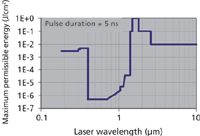
Figure 4: Maximum permissible energy levels for unprotected eyes for a 5-ns pulse of laser light. Note that wavelengths in the visible spectrum must be four orders of magnitude lower in energy for eye safety compared to UV lasers for the pulse width shown here.
Applying Multisensor Capabilities to Explosives Detection
As discussed so far, the advantages of multiple sensors in a single platform are a major benefit for hardware design, but ultimately, the sensor must show improved performance for explosives detection. Ideally, the techniques used in such a platform should be orthogonal. This means that techniques should be able to detect the same materials at similar concentration levels but ought to rely on different metrics and chemical and physical phenomena.
UV Raman and TEPS overlap in their ability to detect most explosives, but they are fundamentally different in terms of physics, making them partially orthogonal methods. UV Raman works well for molecules that have a chromophore (that is, light-absorbing functional groups), and for anions used in explosives, such as nitrate. It is very specific for many molecular explosive compounds and even some mixtures involving inorganic salts, as seen in Figure 5.
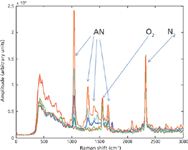
Figure 5: A Raman spectrum of ammonium nitrate (AN) at different concentrations at standoff distances. Each of the AN peaks corresponds to a specific type of bond in the AN ions with the largest peak at 1040 cm-1 corresponding to the symmetric stretch of the NO3â ion.
Unfortunately, UV Raman does not detect metallic materials such as aluminum powder, which can be used as a fuel with many oxidizers or used to make thermite when mixed with iron(III) oxide. On the other hand, TEPS is an excellent elemental detector with high sensitivity, but it is limited in its ability to identify molecules specifically, and it serves mainly as an explosive versus nonexplosive indicator (Figure 6). A summary of the distinct and orthogonal capabilities for TEPS and Raman for a few explosive materials is shown in a color-coded chart in Figure 7.
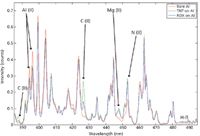
Figure 6: TEPS spectra of TNT and RDX on an aluminum coupon at standoff distances, with notable peaks marked that appear indicative of explosives.
Sensor pairings, even when orthogonal, must also handle potential destruction of the sample when trace detection of explosives is concerned. TEPS, by its nature, involves the ablation of a small amount of material from the interrogated surface, possibly removing the entire explosive. Ablation has the disadvantage of destroying a portion of the sample for increased sensitivity, but it can be used for other purposes. If the Raman methods are used first, followed by TEPS, it is possible not only to do data fusion of the two techniques, but also to perform depth profiling of the surface in case a surface, explosive obscurant is present.
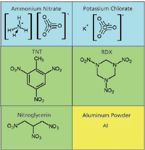
Figure 7: Chemical structures and names of some explosives and flammable materials detectable by a combination of LIBSâTEPS and Raman. Chemicals in blue are easily detected by Raman, those in yellow are best detected by LIBSâTEPS, and those in shades of green have a high probability of detection by either method.
The combination of TEPS with multiwavelength Raman is also a benefit for explosives detection because each technique responds to interferents differently. As shown in Figure 5, nitrogen and oxygen peaks appear in Raman when used at standoff distances. Although these are outside the fingerprint region for most explosives, they can confuse some detection algorithms. The entrainment of air into the plasma in TEPS means that atomic, rather than molecular, oxygen, and nitrogen lines contaminate the spectra. This emission makes detection of ammonium nitrate challenging with TEPS, but the UV Raman approach easily makes up for this difficulty by detecting the ions of the material directly. Other interferents, such as those present on the interrogated surface, potentially can be ameliorated in a similar way.
Finally, multiwavelength UV Raman, though not as orthogonal as the TEPS and Raman configuration, can be considered a valuable sensor pairing by itself for explosives detection. As the absorption of UV radiation increases, the Raman signal intensity can increase because of resonance enhancement, as well as the likelihood of photodecomposition of the sample, especially at high energy densities. Using different UV wavelengths for Raman can safeguard against total photodegradation of the sample when longer wavelengths are in use, while also allowing the system to maximize the return signal when photodegradation from UV exposure at shorter wavelengths is not a problem. Even so, multiwavelength Raman can require data fusion and proper sequencing of the techniques, similar to that needed for combining Raman with TEPS.
As a demonstration of the power of sensor combinations, the CPEDS system and its predecessors repeatedly have performed successfully under government observation. A recent double-blind technical test and military utility assessment of the CPEDS system in an Army test facility showed that Raman and TEPS perform as described previously, though this is an oversimplification of the testing and demonstration. Still, the testing and assessment revealed advantages in using multisensor techniques because the combination of TEPS and Raman spectroscopy methods potentially can expand the detection library of explosives that either technique would have if employed alone with the added advantage of shared hardware.
Conclusion
A single sensor platform using multiple spectroscopic techniques called CPEDS has been created for trace explosives detection. The sensor encapsulates a UV Raman and TEPS sensor in a controlled environment by means of a military shelter designed to fit on a high-mobility multipurpose wheeled vehicle (HMMWV). This enables the sensor to operate in a variety of mission types, such as IED-laboratory sensitive site exploitation or at military checkpoints to detect the transport of explosive materials.
By combining the multiple sensors into a single instrument, the system achieves multiple goals. First, several pieces of hardware can be shared, which reduces costs compared to operating the sensors separately. Second, the combination of multiple sensing technologies allows each technique to operate at maximum sensitivity and selectivity, while also providing an opportunity for sensor fusion. In principle, the overall probability of detection of explosive residues should be increased through sensor fusion, which is possible because of the partially orthogonal nature of the two sensing methods. Third, the number of explosives that can be detected in a multisensor system is greater than for each individual sensor. Fourth, sensor combinations can reduce the chance that interferents will affect detection if the two sensors use different optical phenomena.
Acknowledgments
The authors would like to thank the collaborators and agencies that contributed to this work. These include the Maneuver Support Center of Excellence; U.S. Army Research Lab, Sensors and Electron Devices Directorate; Edgewood Chemical Biological Center; Leonard Wood Institute; U.S. Army Research Lab, Human Engineering and Research Directorate; the Department of Homeland Security; and Lincoln University of Jefferson City, Missouri. Contributors to the development of previous systems include Florida A&M University, Arkansas State University, the University of Hawaii, Missouri Science and Technology University of Rolla, Missouri, and the University of New Hampshire.
References
(1) J.L. Gottfried, F.C. De Lucia, Jr., C.A. Munson, and A.W. Miziolek, Anal. Bioanal. Chem. 23, 283–300 (2009).
(2) J.L. Gottfried, F.C. De Lucia, Jr., R.S. Harmon, C.A. Munson, R.J. Winkel, and A.W. Miziolek, ARL-TR-4240, Aberdeen Proving Ground, MD (2007).
(3) L. Nagli and M. Gaft, Proc. SPIE 6739, 673903 (2007).
(4) D. Killinger, S.D. Allen, R.D. Waterbury, C. Stefano, and E.L. Dottery, Optics Express 15, 12905–12915 (2007).
(5) R.D. Waterbury, A.R. Ford, J.B. Rose, E.L. Dottery, Proc. SPIE 7304, 73041B-6 (2009).
(6) L. Nagli, M. Gaft, Y. Fleger, and M. Rosenbluh, Optical Materials 30, 1747–1754 (2008).
(7) D.D. Tuschel, A.V. Mikhonin, B.E. Lemoff, and S.A. Asher, Appl. Spectro. 64, 425–432 (2010).
Alan R. Ford and Troy McVay are with Alakai Defense Systems, Fort Leonard Wood, Missouri. Rob Waterbury, Darius Vunck, Jeremy Rose, Thomas Blank, Ken Pohl, and Ed Dottery are with Alakai Defense Systems, Largo, Florida. Mikella Hankus, Ellen Holthoff, and Paul Pellegrino are with U.S. Army Research Laboratory, Adelphi, Maryland. Steve D. Christesen and Augustus W. Fountain III are with Edgewood Chemical and Biological Center, Aberdeen Proving Ground, Maryland.

AI Shakes Up Spectroscopy as New Tools Reveal the Secret Life of Molecules
April 14th 2025A leading-edge review led by researchers at Oak Ridge National Laboratory and MIT explores how artificial intelligence is revolutionizing the study of molecular vibrations and phonon dynamics. From infrared and Raman spectroscopy to neutron and X-ray scattering, AI is transforming how scientists interpret vibrational spectra and predict material behaviors.
Real-Time Battery Health Tracking Using Fiber-Optic Sensors
April 9th 2025A new study by researchers from Palo Alto Research Center (PARC, a Xerox Company) and LG Chem Power presents a novel method for real-time battery monitoring using embedded fiber-optic sensors. This approach enhances state-of-charge (SOC) and state-of-health (SOH) estimations, potentially improving the efficiency and lifespan of lithium-ion batteries in electric vehicles (xEVs).
New Study Provides Insights into Chiral Smectic Phases
March 31st 2025Researchers from the Institute of Nuclear Physics Polish Academy of Sciences have unveiled new insights into the molecular arrangement of the 7HH6 compound’s smectic phases using X-ray diffraction (XRD) and infrared (IR) spectroscopy.